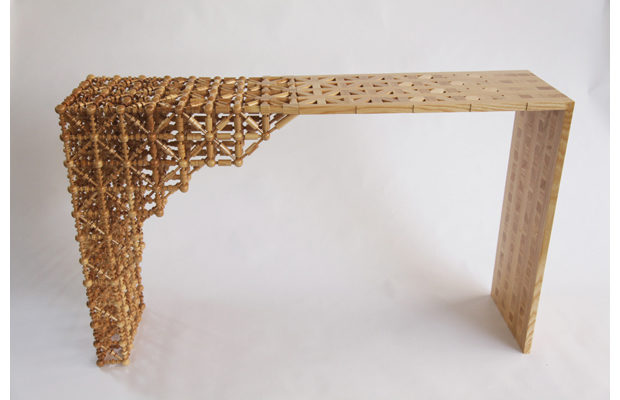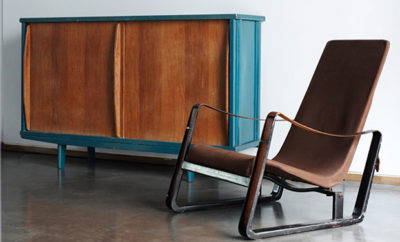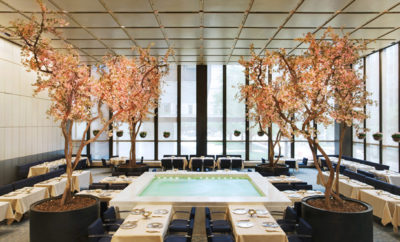
Design
Design Galleries in the Middle East Capturing Attention
THE MIDDLE EAST HAS AN AGE-OLD LEGACY of ceramics, metal, glass, and carved wood, and today a host of contemporary designers is drawing on that heritage for inspiration. “With the region’s rich design traditions going back thousands of years, collectors are drawn to new renditions based on historical artistry, materials, and processes like hand-hammered bronze,” says Cyril Zammit, director of the four-year-old Design Days Dubai. Many designers are fusing ancient craft traditions with the contemporary sensibilities of the West, and with the emergence of new designers has come new galleries to show their work. In turn, a number of those new galleries take part in prestigious international design and art fairs, thus attracting the attention of both seasoned and novice collectors.

Studio mischer’traxler’s Gradient Mashrabiya sideboard, 2012, is made from more than 650 lathed oak pieces, assembled by hand. Photo courtesy Carwan Gallery.
Design Days Dubai was launched in 2012. “Our show was the first design fair in the Middle East and South Asia,” Zammit says. The first show featured a total of twenty-two design dealers. Last year thirty-four gallerists were on hand. Attendance swelled from 8,500 to 12,150. “Last year, we saw the number of dealers from the Middle East triple in number from the original five,” Zammit notes. This year the fair runs from March 16 through March 20.
Zammit says the fair is making a decided effort to reach out to designers to create work that has its origins in the area. In 2013 Design Days Dubai commissioned a table made out of shredded pa- per from the Dubai-based Harper’s Bazaar Interiors Arabia by designer Jens Praet, who is represented by Industry Gallery. “It was a live performance during the fair,” says Zammit. Design Days Dubai donated the table to the Mint Museum in Charlotte, North Carolina.
Although Design Days Dubai offers an annual showcase, throughout the Middle East new design and art galleries are offering major historic art deco and mid-century work and cultivating indigenous design that expresses the special aesthetic sensibilities of the Middle East. Among them are dealers in Doha, Amman, and Sharjah.
But it is two cities, Beirut and Dubai, that offer a starting point to begin to explore this new frontier in design. Beirut in particular has come into the spot- light, aided by the annual Beirut Design Week held each June, and enhanced by the growing reputations of such internationally appreciated designers as Nada Debs, Karina Sukar, and the two-woman team of Bojka, all at work there. Among the pacesetting dealers in Beirut are Carwan Gallery, Smogallery, and Art Factum Gallery.

Nada Debs’s Carving Time vases in hand-carved maple and brass, 2014. Photo courtesy Carwan Gallery.
Founded in 2010 by two architects, Lebanese Pascale Wakim and Montreal-born Nicolas Bellavance-Lecompte, Carwan was the first contemporary design gallery in the region and brings a distinctive approach by not only featuring the work of local designers (from the little known to the more recognized, such as Debs) but also by recruiting designers from Europe to tap into ancient craft traditions and establish a cross-cultural dialogue. “We wanted to create a platform of exchange and discovery, like a bridge between the region and the rest of the world,” Wakim says.
Among the designers Carwan recruited is the Paris-based architect and designer India Mahdavi, who was born in Iran, reared in Germany, France, and the United States, and educated in Paris and New York. Her work runs the gamut from jewelry and furniture to such high profile projects as the Coburg Bar and He?le?ne Darroze restaurant in London’s Connaught Hotel. “Her 2013 brass and ceramic Landscape series is inspired by Ottoman Iznik tiles and created by Turkish craftsmen,” says Wakim of Mahdavi’s tables topped by tiles in shades of turquoise, orange, and yellow. “The combination of cultures appeals to a range of collectors,” she adds.
Carwan made a splash at the inaugural Design Days Dubai with the Viennese design duo of Katharina Mischer and Thomas Traxler, whom he had met the year before at Design Miami Basel. On site in Dubai, the design team assembled a work based on the Middle Eastern traditions of craftsmanship; the resulting attention-grabbing Gradient Mashrabiya sideboard was composed of more than 650 intricate pieces of oak.
Other Carwan designers include the Beirut-born, Milan-based Karen Chekerdjian, who designed a set of three chunky geometric brass side tables, and Tehran-born Taher Asad Bakhtiari, who divides his time between Tehran, Dubai, and New York. His latest efforts are wool rugs with triangular designs against striped backgrounds, which are woven in Iran. “Each Kilim takes four to five months to produce,” Wakim notes. The gallery has plans to open an outpost in Dubai and participates in Design Miami and the Collective Design Fair in New York as well as in Design Days Dubai.

Georges Mohasseb’s Marguerite des sables table, designed 2014, is comprised of 241 hand- wrought brass daisies welded together. Photo courtesy Smogallery.
Smogallery Art and Design was founded by Lebanese architect and interior designer Gregory Gatserelia and opened in 2011. On his schedule are PAD London and Paris along with the Beirut Art Fair. “My collectors are looking for design that is contemporary in spirit,” Gatserelia says. His client base includes collectors from Lebanon, Russia, France, Britain, and Brazil—even Singapore. Among the designers Gatserelia showcases (many of them Lebanese as well) is Danielle Moudaber, who turns out riffs on small Middle Eastern brass round tables. Her Spiderella Kosmica coffee table, 2014, is edged with six round disks intended to invoke the cos- mos and comes in an edition of five with one artist’s proof. Designer Georges Mohasseb also turns to the traditional round brass table. His 2014 Marguerite des sables is composed of 241 elongated daisy-like forms. Gatserelia’s own Multistrata table in white marble and brass is also part of Smogallery’s collection.
Another gallery of note in Beirut is Art Factum. Launched in 2011 by Joy Mardini, who had worked in Christie’s Paris twentieth-century decorative arts department, the gallery focuses on both art and design. Featured is Carlo Massoud, who worked with Umberto and Fernando Campana. His lighting in bronze and stainless steel draws on sculpture for inspiration. Carlo’s sister Mary-Lynn Massoud, who trained in ceramics at Se?vres, works with the Beirut-educated Rasha Nawam to create functional vessels, frequently in amorphous shapes, with some slip-glazed in brilliant hues of yellow and red. Also at the gallery is the lighting of Beirut-born, Rhode Island School of Design graduate Karim Chaya.

Karim Chaya’s Oblique lamps in marble and brass, 2013. Photo courtesy Tashkeel.
Dubai, of course, is host to the annual Design Days Dubai, but it is also home to a growing number of design galleries, among them Tashkeel and La Galerie Nationale. An artist and photographer, Lateefa bint Maktoum opened Tashkeel in 2008 and now participates in Design Days Dubai. “We support, encourage and promote the work of both artists and designers living and working in the Emirates by providing studio facilities, artists’ residencies, international fellowships, and a program of exhibitions and events as well as recreational workshops,” says Jill Hoyle, Tashkeel’s manager. One local designer represented is Latifa Saeed, whose 2014 Braided group consists of chairs, sofas, and an ottoman made up of braided cushioned cotton tubes on wooden frames. Also of note at Tashkeel are the floor and wall coverings called San’ams, comprised of joined hexagonal shapes of camel leather, by Emirati designer Zeinab Alhashemi.

Latifa Saeed’s Braided series employs cotton cushion tubes upholstered on a wooden frame, 2013. Photo courtesy Art Factum.
La Galerie Nationale is headed by Guillaume Cuiry, who was originally based in Paris, where he noted a steady stream of clients from through- out the Middle East, including collectors from Kuwait and Qatar. Cuiry specializes in both modern and contemporary design. Showcased at his gallery is work by such well-known figures as Serge Mouille, Willy Rizzo, and Joe Columbo, along with that of such contemporary designers as the Beirut-born Fadi Sarieddine. An architect based in Dubai, Sarieddine frequently works in stain- less steel; his 2012 Origami desk has a stainless steel base in a checkerboard pattern and a palisander top. Also on view at Galerie Nationale is the work of Iraqi artist and ceramist Sarmad Al-Mussawi, who creates objects that are influenced by Islamic calligraphy.
Dealers exhibiting at the 2014 Design Days Dubai were from around the globe—Europe, Africa, North and South America, and Asia. There were four from Dubai, two from Beirut, and one each from Doha and Amman. Collectors, too, came from around the world. “The fact that collectors from beyond the Middle East, from the States and Europe as well as Russia, come to our fair demonstrates that this area is now a magnet for design collectors,” Zammit says.












